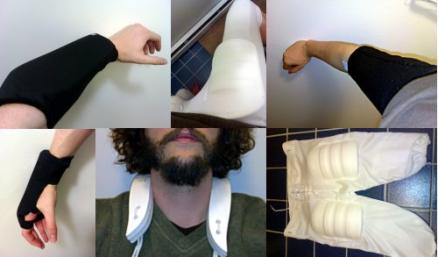haptics
Comfort, Wearables, and a Peripersonal Space Experiment
I've been doing a lot of work on anthropometrics, and I found the articles for this week to be really helpful for my thesis research. I have been thinking about how to measure vital signs on a patient's body in a way that is inexpensive, accurate, and user-friendly, both for the patient and the technician. Equally important, however, is that a measuring device should be wearable, by the authors' definitions, if only for a short time.
In "The Comfort Assessment of Wearable Computers," by James Knight, et al., the authors invented a multidimensional test for describing the feelings of comfort or discomfort for a wearable device. I'm a freak for numbers and hard data, so it's nice to have this tool available to me for evaluating prototypes. I am especially glad to see how the evaluations are broken down, getting rid of the unhelpful, single variable comfortable/uncomfortable and allow researchers to get more toward the point of what actually is making the user uncomfortable with a device.
More specific to the design of the devices themselves, in "Design for Wearability" Gemperle et al. delineated the constraints for device placement, form, allowance of movement, peripersonal space, attachment, and several other considerations. For me, this could work as a checklist as I create new devices and wearables, making sure I've considered all of the problem areas. I especially appreciated their breakdown of good places to site the devices, which helps give me a starting point for how to shape and attach them.
Rounding out the readings, Dunne and Smyth's "Psychophysical Elements of Wearability" dove more into the neurological side of comfort, which I also liked. I have done a bit of work with haptic interfaces before, and the deadening of response to a continuous stimulus is something I've noticed. If you want the user to notice an output, the stimulus must be fresh. On the flip side, if you want the user to not attend to the device, it must be comfortable (that is, it must not irritate the nerves.)
I think the Dunne and Smyth article sums up something for me that I have been thinking about for a while. For a wearable to be successful, in my opinion, it must be peripheral. In their terms, it must be something that is subconsciously processed but not attended to. Important input from the wearable may be perceived by the user and later attended to, but it should otherwise fall into the background noise of the rest of the world.
With all this in mind, I conducted a little experiment with some equipment I picked up at Modell's, a local sporting goods chain store. I picked up a set of Adams Forearm Pads, Adams Football Pants, Adams Football Thigh Pads, Adams Neck Roll (flat contour), a pair of Trace Hand-Guard Plus, Nike Dri-FIT Sliding Pad, and a Nathan L.E.D. Wrist Runner. I put on the pants with the thigh pads inserted, put the forepad on my left forearm, the sliding pad on my upper right arm with the thickest part on my tricep, put the neck roll loosely over my shoulders, and put the hand guard on my left hand. Then I performed ordinary tasks to see how I reacted to these additions to my body in daily life.
 Collage of Sports Protection Equipment: First row: Adams Forearm Pad, Adams Football Thigh Pad, Nike Dri-FIT Sliding Pad Second row: Trace Hand-Guard Plus, Adams Neck Roll (flat contour), Adams Football Pants
Collage of Sports Protection Equipment: First row: Adams Forearm Pad, Adams Football Thigh Pad, Nike Dri-FIT Sliding Pad Second row: Trace Hand-Guard Plus, Adams Neck Roll (flat contour), Adams Football Pants
- Mike's blog
- Comments
- Read more



- 12018 reads
Trauma Bear in Video Format
For our midterm project in Yury Gitman's Interactive Major Studio, we made a teddy bear that had a beating heart, lungs, and tons of sensors that felt chest compressions, its physical orientation (with an accelerometer, ) the instruments placed into its mouth, and a magnet to trip the switch we placed in the "paddle" that would restart his heart.
Here is how the trauma bear play testing went down (maddest possible props to Tracy for editing this):
and here's a clip of what we did leading up to this:
- Mike's blog
- Comments
- Read more



- 4263 reads
Sunday Building Sunday
Here are a few snaps of our build day on Sunday for the Trauma Bear project. It has really come together:
- Mike's blog
- Comments



- 4093 reads
More Trauma Bear Guts
On the heels of our wildly successful play test of the trauma bear, I bring to you images of the ursine innards.

And here's a brief video of the experience:
- Mike's blog
- Comments
- Read more



- 4512 reads
Working Game Code
So, we have working game code for the trauma bear. See the attachments for that.
The first file the processing code and the second is the arduino code.
Photos and videos to come.
- Mike's blog
- Comments



- 4425 reads
State Machine Complete (Maybe)
So, we've got that main processing code ready to go! Sort of. Inti has kicked ass getting the physical states codified, and the processing code looks great with the graphics that Tracy posted. I now need to combine the physical pieces that Jay has built for the intubation and ventilator and accelerometer (all of which are killer!) with the Arduino code with the finished state machine and get the thing running.
Very, very soon, this bear will live! And then die!
Processing code is attached below.
- Mike's blog
- Comments



- 4235 reads
tags
Copyright Mike Edwards 2006-2009. All content available under the Creative Commons Attribution ShareAlike license, unless otherwise noted.







